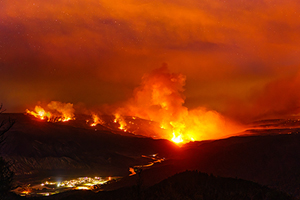 The record-setting statistics from 2020’s fires highlight a threat growing rapidly at the intersection of climate change, location characteristics, and human encroachment on wildlands.
The record-setting statistics from 2020’s fires highlight a threat growing rapidly at the intersection of climate change, location characteristics, and human encroachment on wildlands.
Roughly 10.3 million acres burned across the western United States in 2020*—an almost 50 percent increase over the 10-year average. Four million of those acres burned in California, including the nation’s first “gigafire,” in which 1 million acres burned.
Managing wildfire risk has grown rapidly as a priority for insurers operating in states exposed to this peril, especially over the past ten years. And the latest string of record-breaking events has pushed wildfire toward the center of the industry’s attention. According to Verisk estimates, more than 4.5 million U.S. properties are at a high-to-extreme risk of wildfire, with over 2 million in California.
As mentioned in the recent Verisk webinar, Wildfire in the Age of the Gigafire: Measuring and Mitigating a Growing Risk, rising temperatures, prolonged droughts, and changing precipitation patterns are expanding wildfire “seasons” to a year-round phenomenon. In addition, the session revealed that data has also identified early spring snowmelt in mountainous regions, which extends the dry season, as exacerbating conditions that contribute to large wildfires. Snow cover suppresses wildfire risk, but early snowmelt exposes dry fuel that can ignite and burn. These factors, combined with increasing human encroachment on wildlands, raise the risk of loss.
When addressing the peril of wildfire, one should also consider the mitigating effects of clearing vegetation and defensible space. Mitigating wildfire risk encompasses a range of strategies at both the property and community levels, but putting them into practice can present challenges in terms of feasibility and engagement. The dynamics of wildfire are complex. Controlled lab settings provide data on some mitigation techniques, but much is still needed for real-world wildfires where many factors compete. More research is needed on the interplay of such factors, including defensible space, construction, location, and forest management policies.
Wildfire risk is on a rising long-term trajectory, and it takes diverse, high-quality data to take a scientifically sound measure of the threat.
* National Interagency Fire Center
_________________________________________________
Dr. Arindam Samanta leads the management of Verisk products for property underwriting related to weather and natural hazards. These products include FireLine®, Verisk’s wildfire risk management tool for the insurance industry, and a range of other property risk assessment tools related to hail, wind, and lightning. Additionally, he supports ISO’s personal lines product innovation pipeline and agenda.




















 Are Cars ‘Structures’? Tallying the Damage from the Los Angeles Wildfires
Are Cars ‘Structures’? Tallying the Damage from the Los Angeles Wildfires  New Commercial Auto Exposures: The Evolution of Terror Liability Risk
New Commercial Auto Exposures: The Evolution of Terror Liability Risk  Mercury General Wildfire Losses Will Hit Reinsurance Cover. One Event?
Mercury General Wildfire Losses Will Hit Reinsurance Cover. One Event?  As Life Shifts Gears, Insurance CEO Chases Racing Dream
As Life Shifts Gears, Insurance CEO Chases Racing Dream 